
Jewellery consists of decorative items worn for personal adornment, such as brooches, rings, necklaces, earrings, pendants, bracelets, and cufflinks. Jewellery may be attached to the body or the clothes. From a western perspective, the term is restricted to durable ornaments, excluding flowers for example. For many centuries metal such as gold often combined with gemstones, has been the normal material for jewellery, but other materials such as glass, shells and other plant materials may be used.

A Claddagh ring is a traditional Irish ring in which a heart represents love, the crown stands for loyalty, and two clasped hands symbolize friendship.

A necklace is an article of jewellery that is worn around the neck. Necklaces may have been one of the earliest types of adornment worn by humans. They often serve ceremonial, religious, magical, or funerary purposes and are also used as symbols of wealth and status, given that they are commonly made of precious metals and stones.

A brooch is a decorative jewellery item designed to be attached to garments, often to fasten them together. It is usually made of metal, often silver or gold or some other material. Brooches are frequently decorated with enamel or with gemstones and may be solely for ornament or serve a practical function as a clothes fastener. The earliest known brooches are from the Bronze Age. As fashions in brooches changed rather quickly, they are important chronological indicators. In archaeology, ancient European brooches are usually referred to by the Latin term fibula.

A medal or medallion is a small portable artistic object, a thin disc, normally of metal, carrying a design, usually on both sides. They typically have a commemorative purpose of some kind, and many are presented as awards. They may be intended to be worn, suspended from clothing or jewellery in some way, although this has not always been the case. They may be struck like a coin by dies or die-cast in a mould.

The Honours of Scotland, informally known as the Scottish Crown Jewels, are the regalia that were worn by Scottish monarchs at their coronation. Kept in the Crown Room in Edinburgh Castle, they date from the 15th and 16th centuries, and are the oldest surviving set of crown jewels in the British Isles.

A charmstone or coldstone is a stone or mineral artifact of various types associated with various traditional cultures, including those of Scotland and the native cultures of California and the American southwest. Typically they are elongated or cylindrical and have been shaped by grinding or other human activity, and may be perforated and/or grooved. They are thought to have been regarded as having some religious or magical function, including being talismans, amulets or charms.

Filigree is a form of intricate metalwork used in jewellery and other small forms of metalwork.
St Ninian's Isle is a small tied island connected by the largest tombolo in the UK to the south-western coast of the Mainland, Shetland, in Scotland. It is part of the civil parish of Dunrossness on the South Mainland. The tombolo, known locally as an ayre from the Old Norse for "gravel bank", is 500 metres long. During the summer the tombolo is above sea level and accessible to walkers. During winter, stronger wave action removes sand from the beach so that it is usually covered at high tide, and occasionally throughout the tidal cycle, until the sand is returned the following spring. Depending on the definition used, St. Ninian's is thus either an island, or a peninsula; it has an area of about 72 hectares.
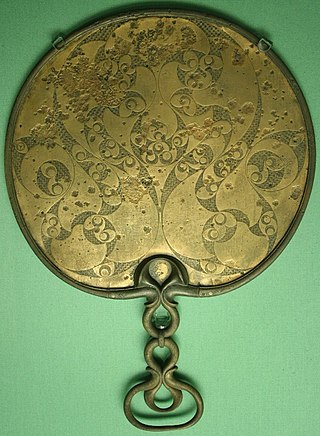
Celtic art is associated with the peoples known as Celts; those who spoke the Celtic languages in Europe from pre-history through to the modern period, as well as the art of ancient peoples whose language is uncertain, but have cultural and stylistic similarities with speakers of Celtic languages.

Queen Elizabeth II owned a historic collection of jewels – some as monarch and others as a private individual. They are separate from the gems and jewels of the Royal Collection, and from the coronation and state regalia that make up the Crown Jewels.
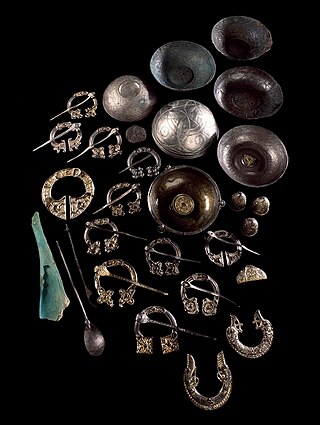
The St Ninian's Isle Treasure, found on St Ninian's Isle, Scotland in 1958 is the best example of surviving silver metalwork from the Early Medieval period in Scotland. The 28-piece hoard includes various silver metalwork items, including twelve pennanular brooches. The treasure is now in the National Museum of Scotland.
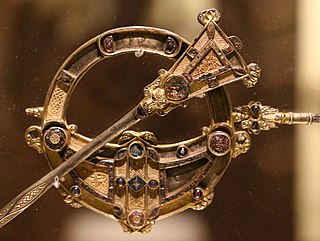
The Celtic brooch, more properly called the penannular brooch, and its closely related type, the pseudo-penannular brooch, are types of brooch clothes fasteners, often rather large; penannular means formed as an incomplete ring. They are especially associated with the beginning of the Early Medieval period in Ireland and Britain, although they are found in other times and places—for example, forming part of traditional female dress in areas in modern North Africa.

In the early Middle Ages, there were distinct material cultures evident in the different federations and kingdoms within what is now Scotland. Pictish art was the only uniquely Scottish medieval style; it can be seen in the extensive survival of carved stones, particularly in the north and east of the country, which hold a variety of recurring images and patterns. It can also be seen in elaborate metal work that largely survives in buried hoards. Irish-Scots art from the kingdom of Dál Riata suggests that it was one of the places, as a crossroads between cultures, where the Insular style developed.
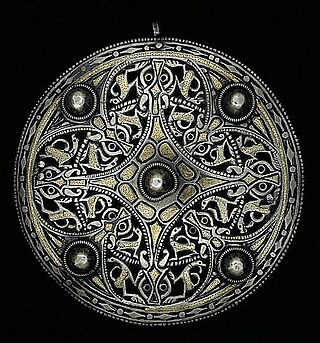
Trewhiddle style is a distinctive style in Anglo-Saxon art that takes its name from the Trewhiddle Hoard, discovered in Trewhiddle, Cornwall in 1770. Trewhiddle ornamentation includes the use of silver, niello inlay, and zoomorphic, plant and geometric designs, often interlaced and intricately carved into small panels. It was primarily used to decorate metalwork. During the late Anglo-Saxon era, silver was the precious metal most commonly used to create Trewhiddle style jewellery and to decorate weapons. Famous examples include the Pentney Hoard, the Abingdon sword, the Fuller brooch, and the Strickland brooch.

Scottish jewellery is jewellery created in Scotland or in a style associated with Scotland, which today often takes the form of the Celtic style. It is often characterised by being inspired by nature, Scandinavian mythology, and Celtic knot patterns. Jewellery has a history in Scotland dating back to at least the Iron Age.

Anglo-Saxon brooches are a large group of decorative brooches found in England from the fifth to the eleventh centuries. In the early Anglo-Saxon era, there were two main categories of brooch: the long (bow) brooch and the circular (disc) brooch. The long brooch category includes cruciform, square-headed, radiate-headed, and small-long brooch brooches. The long brooches went out of fashion by the end of the sixth century.
The Beeston Tor Hoard is an Anglo-Saxon jewellery and coin hoard discovered in 1924 at Beeston Tor in Staffordshire. The hoard consists of forty-nine coins, two silver brooches with Trewhiddle style decoration, three finger rings, and miscellaneous fragments. The coins date the burial of the hoard to approximately 875 AD.
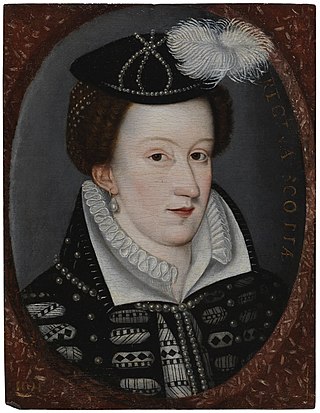
The jewels of Mary, Queen of Scots (1542–1587), are mainly known through the evidence of inventories held by the National Records of Scotland. She was bought jewels during her childhood in France, adding to those she inherited. She gave gifts of jewels to her friends and to reward diplomats. When she abdicated and went to England many of the jewels she left behind in Scotland were sold or pledged for loans, first by her enemies and later by her allies. Mary continued to buy new jewels, some from France, and use them to reward her supporters. In Scotland her remaining jewels were worn by her son James VI and his favourites.
James Gray was a Scottish goldsmith working in Edinburgh during the reigns of Mary, Queen of Scots and James VI of Scotland. Gray is known for the "Galloway mazer", a gilt cup now held by the National Museums of Scotland. He also engraved the brass plate for the tomb of Regent Moray in St Giles, Edinburgh.

















